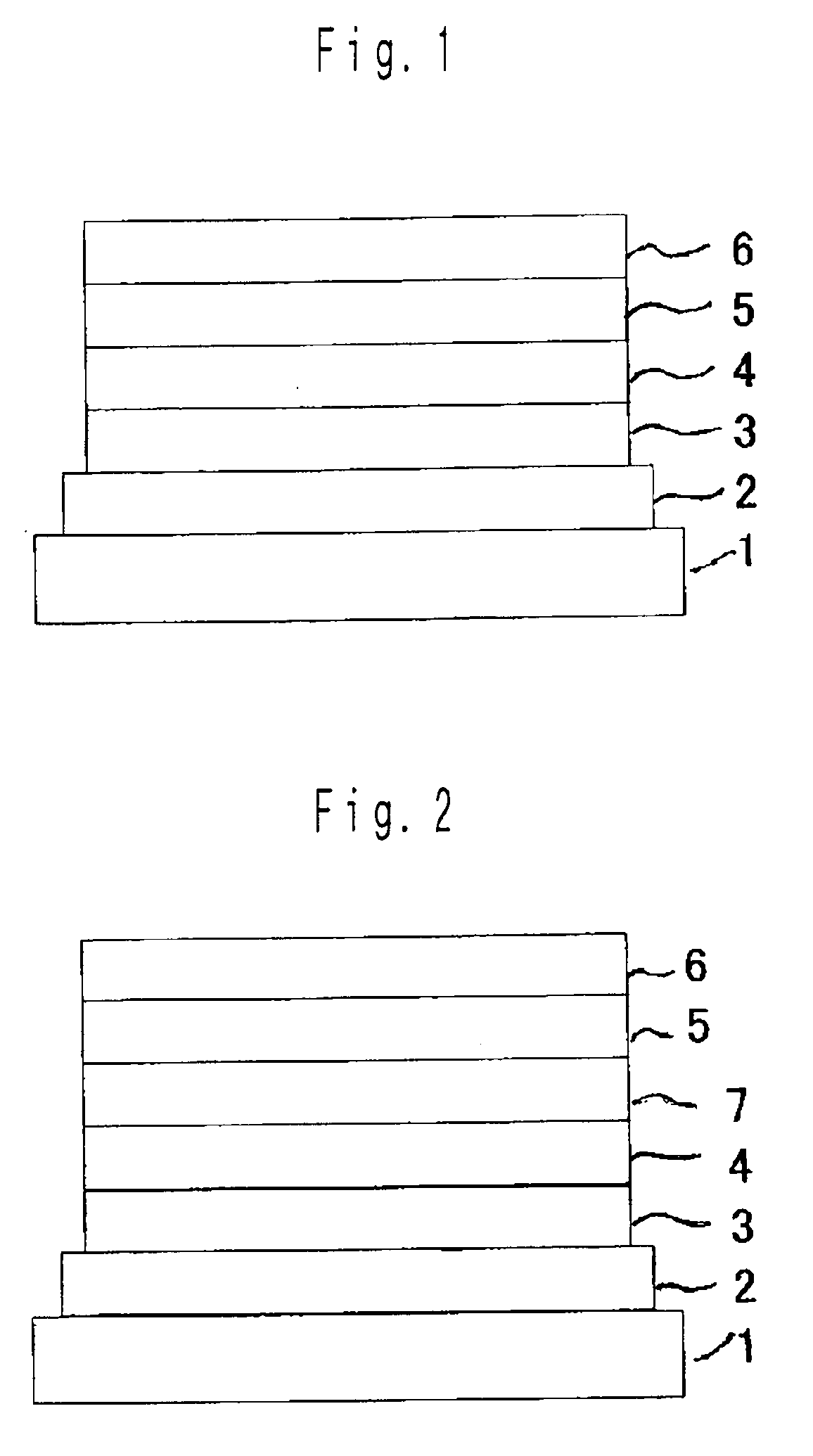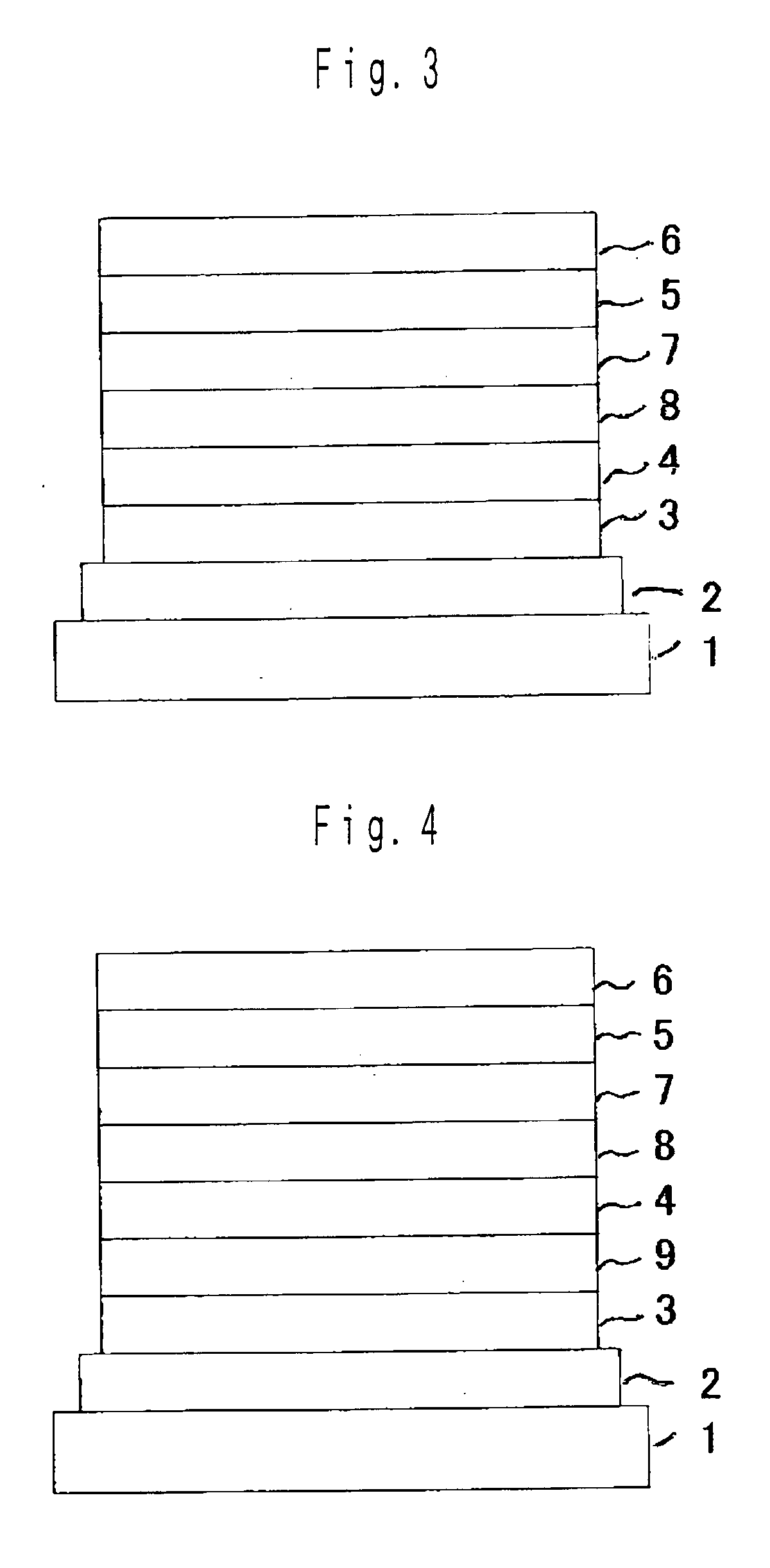Organic compound, charge-transporting material, composition for charge-transporting material and organic electroluminescent device
- Summary
- Abstract
- Description
- Claims
- Application Information
AI Technical Summary
Benefits of technology
Problems solved by technology
Method used
Image
Examples
example 1
Target Compounds 1 and 2
[0325]
[0326]Under a nitrogen stream, carbazole (12.7 g), p-diiodobenzene (25.0 g), a copper powder (4.82 g), potassium carbonate (21.0 g), and tetraglyme (45 mL) were stirred at 145° C. for 5 hours and then left standing to cool to room temperature. Chloroform was added to the reaction mixture. The insoluble matter was filtered off. Chloroform contained in the filtrate was evaporated under reduced pressure. Purification was performed by silica-gel column chromatography (n-hexane / toluene: 4 / 1) to yield Target Compound 1 (11.2 g).
[0327]Under a nitrogen stream, Target Compound 1 (8.01 g), 2-hydroxybenzimidazole (1.04 g), a copper powder (1.38 g), potassium carbonate (6.44 g), and tetraglyme (20 mL) were stirred at 200° C. for 8 hours and then left standing to cool. A copper powder (1.39 g) was added thereto. The resulting mixture was stirred at 200° C. for 6 hours. After the mixture was left standing to cool, chloroform and activated clay were added to the react...
example 2
Target Compounds 3 and 4
[0331]
[0332]Under a nitrogen stream, 2-hydroxybenzimidazole (5.41 g), m-dibromobenzene (28.6 g), copper(I) iodide (15.3 g), potassium carbonate (22.3 g), and N,N-dimethylformamide (130 mL) were stirred at 150° C. for 6.5 hours and then left standing to cool to room temperature. Water was added to the reaction mixture. After the mixture was extracted with ethyl acetate, the organic layer was dried over magnesium sulfate and then concentrated to yield a residue. Toluene and activated clay were added to the residue. The resulting mixture was stirred. The insoluble matter was filtered off. Chloroform contained in the filtrate was evaporated under reduced pressure. Methanol was added thereto. The mixture was stirred. The resulting precipitate was recrystallized in methanol to yield Target Compound 3 (4.36 g).
[0333]Under a nitrogen stream, Target Compound 3 (4.36 g), carbazole (5.76 g), a copper powder (1.88 g), potassium carbonate (8.15 g), and tetraglyme (20 mL) ...
example 3
Target Compound 5
[0338]
[0339]A tris(dibenzylideneacetone)dipalladium(0)-chloroform complex (0.12 g), tri-tert-butylphosphine (0.209 g), and toluene (5 mL) were stirred at 60° C. for 5 minutes in a nitrogen atmosphere to prepare a solution. Under a nitrogen stream, the resulting solution was added to a solution containing 1,3-bis(4-bromophenyl)-1,3-dihydrobenzimidazol-2-one (2.60 g), N-(4-biphenyl)aniline (4.31 g), sodium tert-butoxide (2.25 g), and toluene (35 mL). The mixture was heated to reflux for 9.5 hours with stirring. After the reaction mixture was left standing to cool, activated clay and chloroform were added thereto. The mixture was stirred. The insoluble matter was filtered off. Methanol (200 mL) was added thereto. After the mixture was stirred, the resulting precipitate was filtered. The solid was purified by silica-gel column chromatography (toluene) and washed with a dichloromethane / methanol mixture to yield Target Compound 5 (2.55 g).
[0340]DEI-MS: m / z=772 (M+)
[0341]T...
PUM
 Login to View More
Login to View More Abstract
Description
Claims
Application Information
 Login to View More
Login to View More - R&D
- Intellectual Property
- Life Sciences
- Materials
- Tech Scout
- Unparalleled Data Quality
- Higher Quality Content
- 60% Fewer Hallucinations
Browse by: Latest US Patents, China's latest patents, Technical Efficacy Thesaurus, Application Domain, Technology Topic, Popular Technical Reports.
© 2025 PatSnap. All rights reserved.Legal|Privacy policy|Modern Slavery Act Transparency Statement|Sitemap|About US| Contact US: help@patsnap.com



